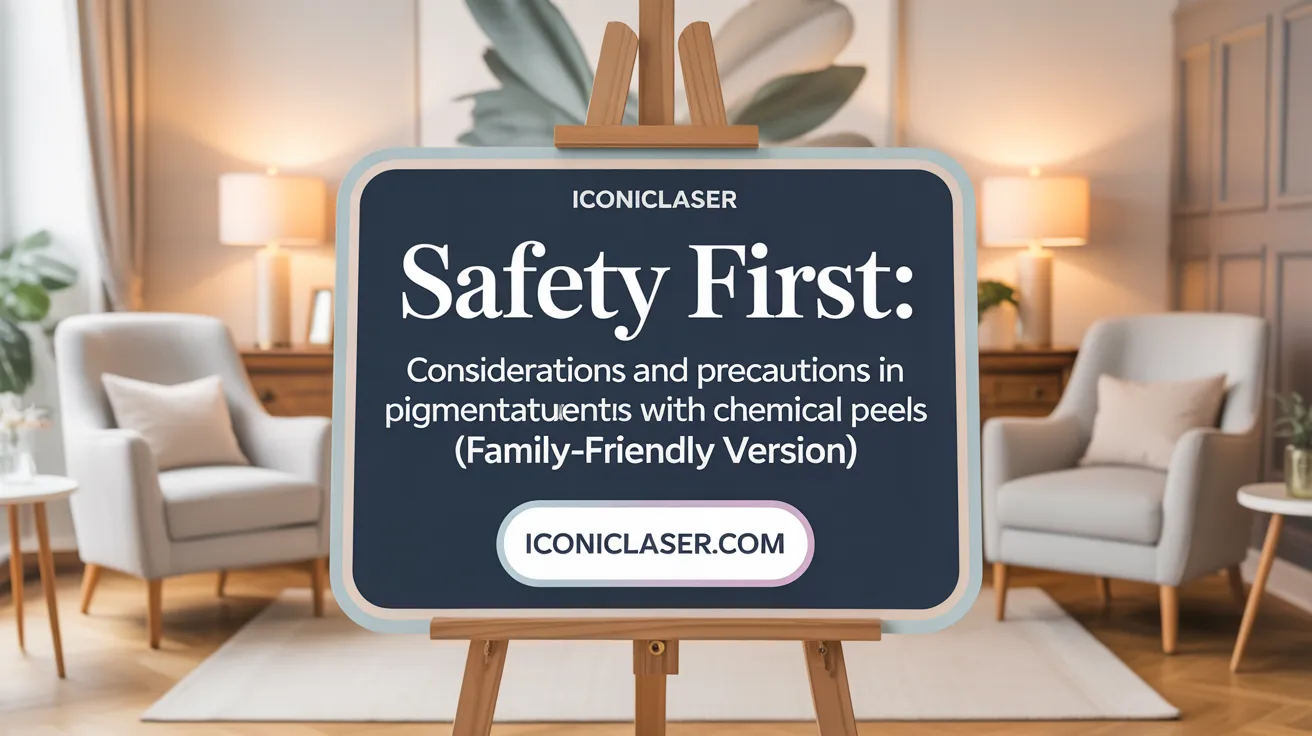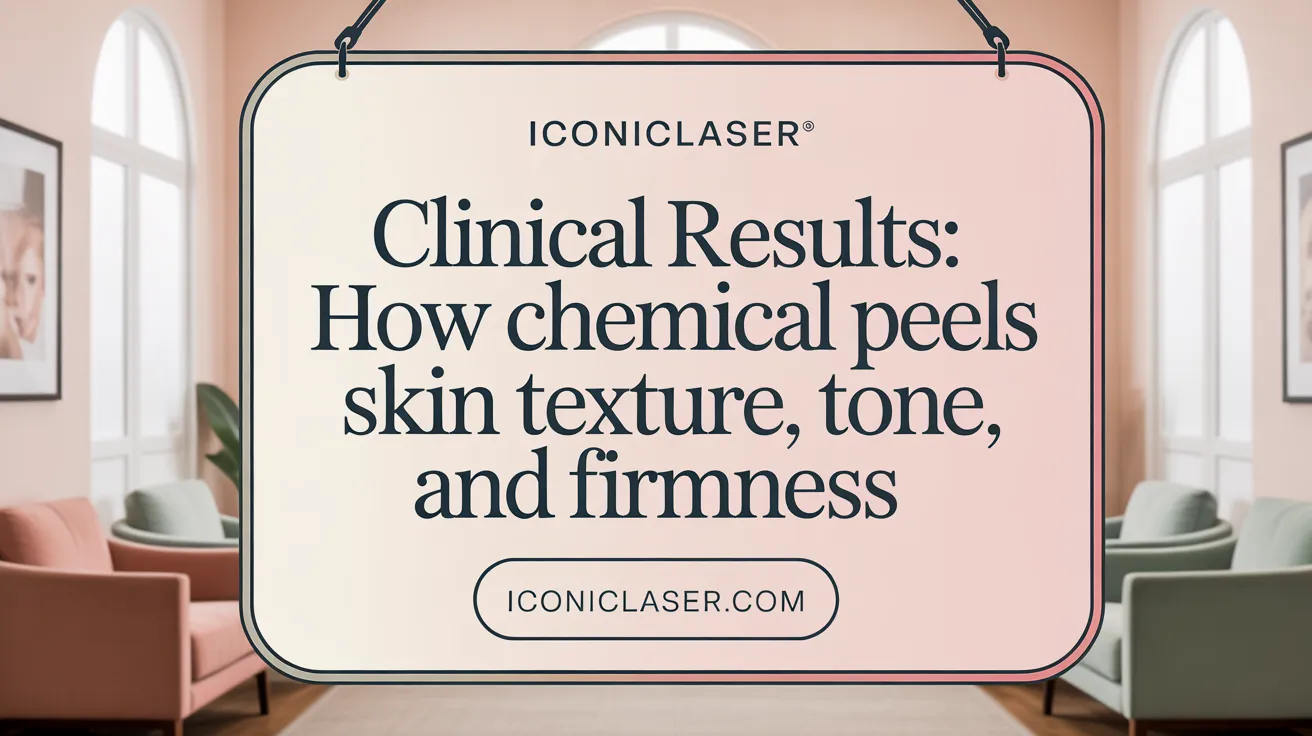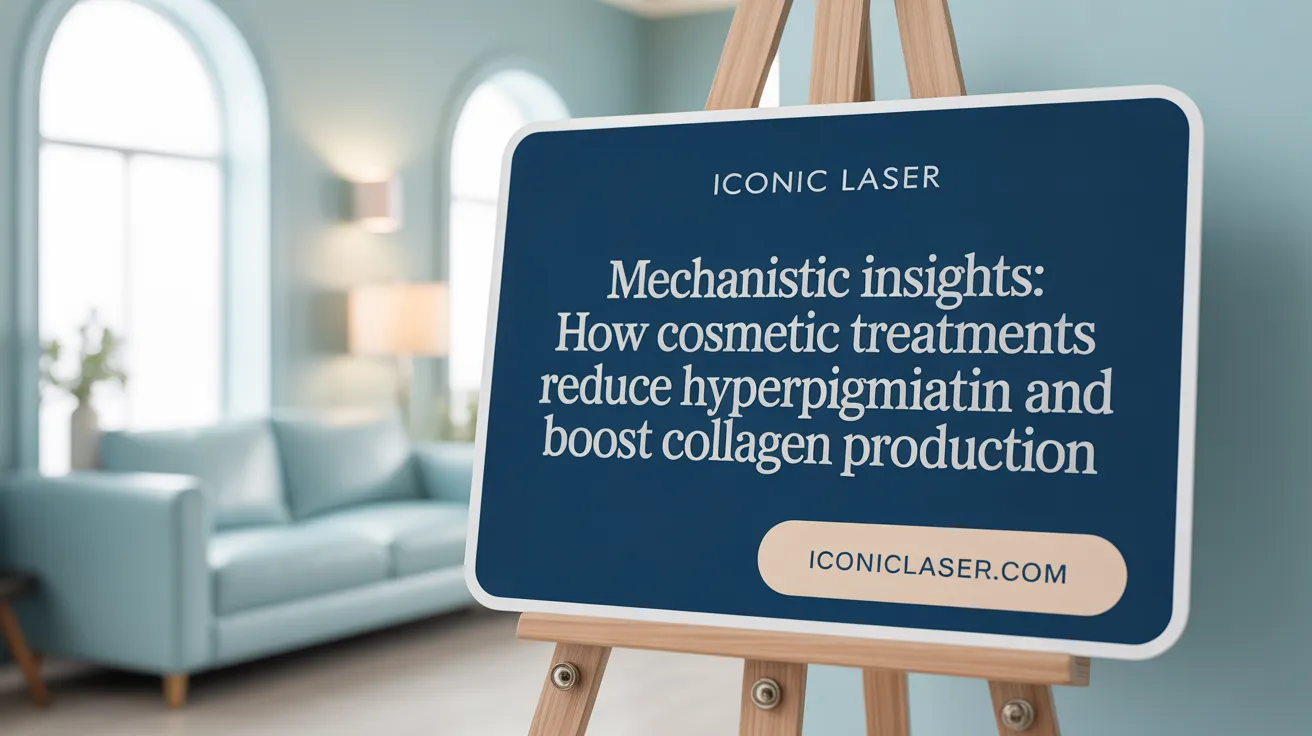Introduction to Chemical Peels and Their Dual Impact on Skin
Chemical peels have become a cornerstone in cosmetic dermatology for their dual capacity to enhance skin appearance by reducing pigmentation and stimulating collagen production. This article explores the clinical outcomes, scientific mechanisms, and safety considerations associated with different depths and types of chemical peels, offering evidence-based insights into their role in skin rejuvenation.
Chemical Peels for Pigmentation and Collagen Stimulation
- Superficial peels using alpha hydroxy acids like glycolic acid (20-35%) are effective for mild hyperpigmentation with minimal downtime.
- Chemical peels reduce melanin by promoting epidermal turnover and may also modulate melanocyte activity to decrease melanin production.
- Extensive clinical evidence shows that chemical peels produce significant improvements in skin brightness, evenness of tone, and texture, especially with repeated treatments.
- Proper patient selection and technique are essential to minimize risks like post-inflammatory hyperpigmentation and avoid adverse reactions, especially in darker skin types.
- Chemical peels stimulate collagen through controlled skin injury, leading to increased fibroblast activity and collagen remodeling for firmness and rejuvenation.
- The extent of collagen synthesis correlates with peel depth, with medium and deep peels inducing more substantial skin tightening.
- Clinical data demonstrate that superficial peels improve texture within days, while medium-depth peels yield more pronounced smoothing and scar reduction over 1-2 weeks.
- Deep peels can produce over 50% improvement in skin irregularities and require longer recovery times due to their penetrative depth.
- Chemical peels invoke mechanisms involving keratolysis and fibroblast activation, leading to pigment removal and collagen boost for skin rejuvenation.
- While effective, chemical peels carry risks like erythema, irritation, hyperpigmentation, scarring, and require expert administration and strict post-care for safe, successful outcomes.
1. Chemical Peels and Pigment Reduction: Clinical Efficacy and Mechanistic Insights

What types of chemical peels are used for targeting pigmentation?
Chemical peels are classified based on their depth of skin penetration, which influences their use in treating hyperpigmentation. Superficial peels, such as those using alpha hydroxy acids (AHAs) like glycolic acid at concentrations of 20-35%, are effective in lightening dark spots and evening skin tone with minimal downtime. Medium-depth peels, often using trichloroacetic acid (TCA), can treat more stubborn pigmentation, including melasma and pigmentary dyschromias. Deep peels, such as phenol peels, are generally reserved for severe cases due to higher risks and longer recovery. Recent advancements include multi-acid formulations and combination peels like the VI Pigmentation Peel, designed to optimize results across various skin types.
How do chemical peels influence melanin production in the skin?
Chemical peels primarily reduce excess melanin by accelerating the exfoliation of pigmented epidermal layers. They disrupt melanin synthesis by promoting cell turnover, which leads to the removal of pigmented keratinocytes. Peels containing AHAs like glycolic acid act on the epidermis by decreasing cell cohesion and encouraging the shedding of melanin-rich cells. Additionally, some peels induce epidermolysis, which facilitates reepithelization with less pigmented skin. They can also modulate local melanocyte activity, reducing overproduction of melanin in conditions like melasma. This process results in a visibly lightened complexion and more uniform skin tone.
Can chemical peels effectively reduce skin pigmentation? What are the clinical evidence and results?
Extensive clinical studies support that chemical peels improve skin pigmentation significantly. For instance, randomized controlled trials have documented reductions in hyperpigmentation after series of glycolic acid peels, showing an increase in skin brightness and uniformity. Newman et al. reported increased collagen content and epidermal thickening, leading to better skin texture and tone. In darker skin types (Fitzpatrick IV and V), superficial and medium-depth peels like glycolic acid and salicylic acid have demonstrated safety and efficacy, with minimal risk of hyperpigmentation if performed properly.
Clinical assessments using standardized scales show improvements in pigment uniformity and overall skin tone. For example, studies employing the Uniformity of Pigment Scale and Skin Tone Scale have reported average reductions of around 59-70%, indicating substantial pigment lightening and improved skin appearance. These outcomes are maintained through regular treatments and proper sun protection.
What safety considerations are associated with pigmentation treatments using chemical peels?
While chemical peels are generally safe when performed by experienced clinicians, potential side effects include erythema, edema, crusting, transient irritation, and in some cases, post-inflammatory hyperpigmentation (PIH) or scarring. Proper patient selection, skin priming, and adherence to protocols minimize these risks. For darker skin types, superficial peels are preferred to reduce the likelihood of PIH. Patients with active infections, keloid tendencies, or allergies should avoid certain peels.
Post-treatment care, including strict photoprotection, use of topical agents, and monitoring for early signs of adverse effects, is crucial. For instance, a case involving a woman on low-dose isotretinoin who received a glycolic acid peel experienced hyperpigmentation and scarring, highlighting that careful assessment and follow-up are essential.
How do combination therapies enhance pigment reduction?
Combining chemical peels with topical agents like hydroquinone, tretinoin, or corticosteroids enhances depigmenting outcomes by targeting skin pigmentation on multiple levels. For example, glycolic acid peels combined with topical hydroquinone produce better results than either modality alone. Furthermore, pairing peels with laser treatments or oral depigmenting agents like tranexamic acid reduces the risk of adverse effects like PIH and accelerates improvements.
Recent innovations include the integration of peel technologies with neurotoxins like Botox, which not only improve skin texture but also optimize overall aesthetic outcomes, including pigmentation. Multi-step protocols involving peels, topical lightening agents, and sun protection are considered the most effective long-term strategies for managing hyperpigmentation.
| Peel Type | Typical Agents & Concentrations | Main Uses | Safety Profile |
|---|---|---|---|
| Superficial | Glycolic acid (20-35%), SA (20-30%) | Mild hyperpigmentation, melasma, photoaging | Very safe, minimal downtime |
| Medium-depth | TCA (35-50%), Glycolic acid (50%) | Melasma, stubborn pigmentation, superficial scars | Slightly longer recovery, higher risk |
| Deep | Phenol, TCA >50% | Severe photoaging, deep scars | Longer healing, higher risks |
In conclusion, chemical peels are a well-researched, effective option for pigmentation reduction. When selected appropriately and performed with care, they offer significant skin lightening, improved texture, and long-term skin rejuvenation.
2. Collagen Stimulation and Skin Remodeling Outcomes from Chemical Peel Treatments

Do chemical peels stimulate collagen production?
Yes, chemical peels do stimulate collagen production. The controlled injury caused by the chemical agents triggers the skin's healing process, initiating increased synthesis of new collagen fibers within the dermis. This collagen remodeling enhances skin firmness, elasticity, and overall texture, helping to diminish wrinkles, scars, and other aging signs.
The depth and type of peel play a vital role in determining the extent of collagen stimulation. Medium and deep peels typically induce more substantial collagen remodeling compared to superficial ones. As a result, they can produce more noticeable skin tightening and rejuvenation effects.
Overall, collagen stimulation is one of the main mechanisms through which chemical peels improve skin quality and treat various dermatological conditions. It promotes skin regeneration, leading to a more youthful, smoother appearance.
What clinical data or study results illustrate expected improvements in skin after chemical peels?
Research confirms that chemical peels lead to significant improvements in skin tone, texture, and pigmentation.
Clinical studies have employed various assessment techniques, such as imaging analysis and histological evaluation, to document these effects. For example, objective image analysis using Gray Level Co-occurrence Matrix (GLCM) analysis has demonstrated decreased contrast and increased homogeneity after peel treatments, indicative of more uniform skin texture.
Superficial peels like glycolic acid often promote rapid epidermal regeneration within days post-treatment. This leads to gradual improvements, especially when treatments are repeated over time, making them effective for conditions like acne and melasma.
Medium-depth peels have shown to produce more pronounced results, including smoother skin surfaces, visible reduction of fine lines, and scar improvement. Healing periods typically span one to two weeks, during which skin regenerates and remodels.
Deep chemical peels are capable of delivering more dramatic changes, with many reports citing over 50% improvement in skin irregularities, wrinkles, and scars. These results are often evident after the entire healing process concludes.
In summary, clinical evidence supports that different peel depths are effective tools for targeted skin improvements. Objective measures and patient-reported outcomes consistently demonstrate the rejuvenating potential of chemical peel treatments.
| Peel Depth | Expected Skin Improvements | Supporting Evidence | Typical Recovery Time |
|---|---|---|---|
| Superficial | Skin texture refinement, mild wrinkle reduction, hyperpigmentation fade | GLCM analysis; rapid epidermal turnover | Several days to 1 week |
| Medium | Noticeable smoothing, scar reduction, fine wrinkle diminishment | Histological collagen increase; patient assessments | 1-2 weeks |
| Deep | Significant wrinkle and scar improvement, skin tightening | >50% lesion improvement; clinical evaluations | 2+ weeks with longer downtime |
This data underscores the versatility of chemical peels in skin rejuvenation, with outcomes tailored to peel depth and treatment goals.
Exploring the Mechanisms Behind Chemical Peel Effects on Pigmentation and Collagen

What are the mechanisms of action for chemical peels in reducing hyperpigmentation and stimulating collagen synthesis?
Chemical peels work by inducing controlled injury to the skin, which triggers a series of regenerative responses. To target hyperpigmentation, the peeling agents such as glycolic acid, salicylic acid, or trichloroacetic acid (TCA) dismantle the excess melanin and damaged skin layers. These acids penetrate the epidermis, breaking down keratinocytes that contain abnormal pigment and removing them through exfoliation. In addition, many peels incorporate ingredients like hydroquinone, kojic acid, or other tyrosinase inhibitors, which directly hinder melanin synthesis at the cellular level.
The injury caused by chemical peels stimulates an inflammatory response that activates dermal fibroblasts — the cells responsible for producing collagen and elastin fibers. This process, known as collagen remodeling, results in increased synthesis of new collagen, which enhances skin firmness and elasticity. As fibroblasts regenerate, the organized collagen network contributes to smoother and more youthful skin.
The depth of penetration plays a critical role. Superficial peels mainly affect the epidermis, leading to superficial exfoliation and pigment removal, ideal for addressing sun spots and uneven tone. Medium-depth peels reach the papillary dermis, stimulating a more significant collagen response for deeper wrinkles and scars. Deep peels affecting the reticular dermis cause extensive collagen remodeling but require longer recovery and carry higher risks.
During the process, keratolysis — the breakdown of keratin — accelerates the shedding of pigmented and damaged skin cells. Simultaneously, protein denaturation within cells releases signals that stimulate new collagen production. This dual action reduces hyperpigmentation and rejuvenates the skin, resulting in a clearer and more even complexion.
In summary, chemical peels orchestrate a balance of exfoliation and biological stimulation. They remove pigmented, damaged epidermal layers while activating dermal fibroblasts to produce new collagen. This combination leads to improved skin texture, reduced wrinkles, and more uniform skin tone, making chemical peels a favored treatment for skin rejuvenation.
Safety and Efficacy of Chemical Peels in Pigment and Collagen Treatments
What are the efficacy and safety considerations of chemical peels for pigmentation improvement and collagen enhancement?
Chemical peels are widely appreciated for their ability to improve skin pigmentation and stimulate collagen production. These effects lead to better skin texture, firmness, and a more youthful appearance. The success of a peel largely depends on the type—superficial, medium, or deep—the concentration of the peeling agent, and individual skin characteristics.
Superficial peels, such as those using glycolic acid or salicylic acid, are effective in treating mild pigmentation issues like hyperpigmentation, melasma, and age spots. They mainly exfoliate the outermost skin layers, promoting cellular turnover and collagen stimulation. Medium-depth peels containing trichloroacetic acid (TCA) can target more pronounced pigmentation and aid in removing damaged skin layers, thus providing more significant rejuvenation.
Deep peels, like phenol-based treatments, penetrate into the reticular dermis, offering the most substantial changes including deep wrinkles and severe photoaging. However, they carry higher risks such as scarring, hypopigmentation, and longer recovery times.
Safety considerations are paramount. Risks include erythema, irritation, persistent hyperpigmentation or hypopigmentation, and rare but serious complications like scarring or keloids. Phenol peels especially require meticulous patient selection.
To optimize outcomes and minimize adverse effects, proper skin priming before treatment, correct peel concentration, accurate neutralization, and diligent post-treatment care—including sun protection—are essential. When performed by experienced professionals, chemical peels serve as a reliable method for pigmentation correction and collagen enhancement.
What are common side effects or adverse reactions associated with chemical peels?
Common side effects include redness, dryness, peeling, and mild swelling that typically resolve within days to weeks. Immediate reactions during peel application often involve a sensation of burning or stinging. Post-procedure, the skin can exhibit transient hyperpigmentation or hypopigmentation, especially in darker skin types or if not adequately protected from sun exposure.
In some cases, more serious adverse reactions may occur, particularly with deeper peels. These include infections, prolonged erythema, scarring, textural changes, and heightened risk of post-inflammatory hyperpigmentation (PIH). Phenol-based peels, while effective, can lead to systemic toxicity if not carefully administered.
Other potential adverse effects include allergic contact dermatitis, herpes reactivation, and accidental injury to the eyes if not properly protected. The risk of scarring or uncontrolled pigmentation increases with improper technique, inadequate patient selection, or failure to follow pre- and post-procedure guidelines.
To mitigate these effects, thorough patient assessment, appropriate peel depth and agent selection, and post-treatment skin care are crucial. Regular follow-ups help to monitor healing and address complications early.
| Aspect | Description | Additional Notes |
|---|---|---|
| Common side effects | Redness, peeling, swelling, transient hyperpigmentation | Usually resolve with care |
| Severe adverse effects | Scarring, persistent hyper/hypopigmentation, infections | Higher in deep peels |
| Special risks | Herpes flare-up, ocular injury | Require protective measures |
| Management tips | Sun avoidance, skin priming, and follow-up | Essential for safe outcomes |
Overall, chemical peels are a safe and effective tool for skin rejuvenation and pigment correction when performed under proper medical supervision, with attention to individual skin types and proper aftercare.
Concluding Insights on Chemical Peel Outcomes for Skin Enhancement
Chemical peels represent a scientifically supported, effective approach to improving skin pigmentation and stimulating collagen production, thereby enhancing skin tone, texture, and overall appearance. Clinical evidence from various peel depths demonstrates significant benefits in reducing hyperpigmentation, promoting epidermal renewal, and inducing collagen remodeling, which collectively contribute to a more youthful and vibrant complexion. While the outcomes are promising, the importance of professional administration, appropriate patient assessment, and adherence to pre- and post-treatment care protocols cannot be overstated to ensure safety and optimize results. Advances in peel formulations and combination therapies continue to enhance efficacy and safety profiles, offering tailored solutions for diverse skin types and conditions. Ultimately, chemical peels remain a valuable tool in dermatologic and cosmetic practice, delivering measurable improvements in skin health and aesthetics.
References
- Evidence and Considerations in the Application of Chemical Peels ...
- Demystifying the mechanism of action of professional facial peeling
- Chemical Peels for Hyperpigmentation: Even Skin Tone
- Chemical Peeling: A Useful Tool in the Office - ScienceDirect
- Review of chemical peeling in photoaging skin
- Severe hyperpigmentation and scarring following glycolic acid peel ...
- (PDF) Chemical peeling for acne and melasma: current status and ...
- Optimized Patient Outcomes With the Novel Modality of Corrective ...
- A novel professional‐use synergistic peel technology to reduce ...
- Role of chemical peels in postinflammatory hyperpigmentation
